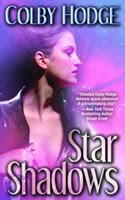Author Cindy Holby, who writes science fiction romance as Colby Hodge, revealed a recent career obstacle which she blogged about at Alien Romances: “Since my publisher did not want to go with more Star books I wrote up a proposal on another series. A sci/fi heavy post apocolyptic [sic] world that would cover three books. It had mech heroes, paranormal heroines, and three different societies all struggling for control. I shopped it around to several different publishers and it got rejected at each one. There was no empathy for the characters. Quite a blow to me, who writes strong character driven stories.
“Since my publisher did not want to go with more Star books I wrote up a proposal on another series. A sci/fi heavy post apocolyptic [sic] world that would cover three books. It had mech heroes, paranormal heroines, and three different societies all struggling for control. I shopped it around to several different publishers and it got rejected at each one. There was no empathy for the characters. Quite a blow to me, who writes strong character driven stories.
“Also this market is just not strong enough at the moment. The fan base just is not there. The fans are hard core but the numbers don’t support it. While I love the genre, my sales in historicals are four times what I sell in sci-fi.”
In the post, Ms. Holby shared her proposal, presumably the same one she shopped to editors. The story elements look interesting and based on those, I’d sure read it. But apparently, I’m in the minority.
Hmmm. Although I suppose that depends on how one defines “minority.”
Angela James tweeted on 5/26/09 that the “Top sellers in erotica on Fictionwise seem to fall into 1 of 4 categories: m/m, paranormal, BDSM, futuristic” [emphasis mine]. Yes, there are distinct differences between futuristic erotica and SFR, but gee, it’s one of the top sellers?
I know. Comparing ebooks and erotica to traditional mainstream print publishing is like the proverbial apples and oranges. And it’s not going to help authors like Cindy Holby sell more books or proposals right now. But I wonder…are those consumers of SF erotica potential science fiction romance fans? Might we consider some kind of outreach to engage those readers in SFR?
This issue also reminds me of a certain trend in historical romances: that readers in general seem to prefer stories in certain settings and time periods (e.g., medieval England or 17th/18th century Scotland). We encounter a similar stumbling block with SFR, namely, that it is—or appears to be—too exotic for some readers.
But perhaps not for readers of erotica.
And surely there are romance readers who have never read SF or SFR, yet watched and enjoyed J.J. Abrams reboot of STAR TREK. Which meant that STAR TREK might be an example of a story that makes science fiction more alluring. If STAR TREK were re-imagined as a romance, would that draw new readers? Part of the challenge is finding the stories that open new doors at a time when readers are willing to step through them. In other words, for example, paranormal romances existed before the big boom, so did the stories change, or did readers?
Willingness to take a chance on something different is an issue. Are readers willing to adjust their expectations for subgenres like SFR, or for historical romances taking place in different settings? (According to agent Jessica Faust, one reason stories set in other countries don’t sell is that “Americans tend to stereotypically be a little internationally challenged.”) And even if readers are willing to change, will publishers answer the call?
Even if it’s a fact that readers are futuristically challenged, it doesn’t necessarily mean they shouldn’t be given the choice to read an SFR. According to PW’s When Love Is Strange: Romance Continues its Affair with the Supernatural, St. Martin’s Press' Senior Editor Monique Patterson reminds us that “…everything is cyclical in terms of popularity. Eight or nine years ago, you couldn’t give away paranormal romance.”
Clearly, readers expand their horizons if given the chance.
Next time, I’ll explore what those chances might look like.
In the meantime, if you’re a fan of science fiction romance and want to see it continue, word-of-mouth and buying the books of your favorite authors—especially new—is important now more than ever.
Joyfully yours,
Heather